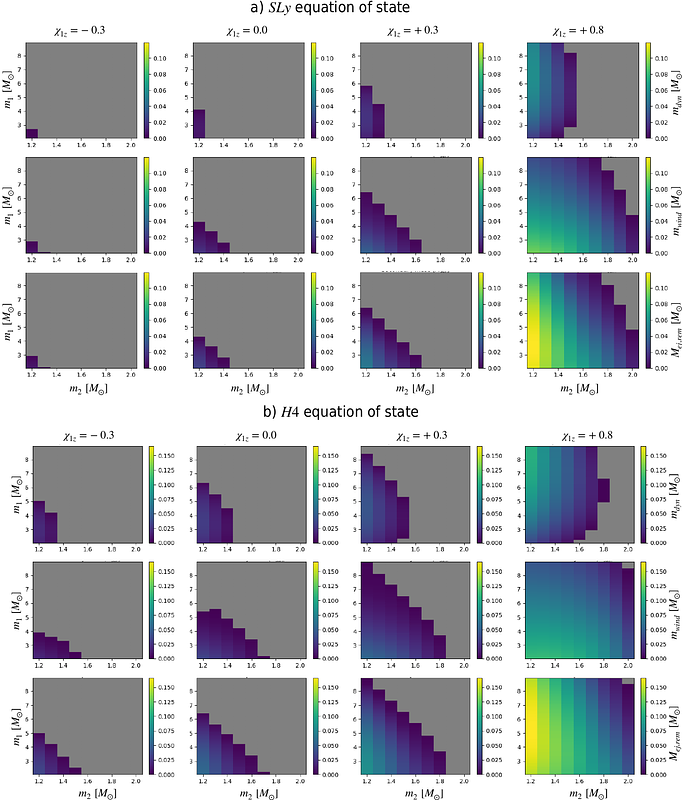Limits on the Ejecta Mass During the Search for Kilonovae Associated with Neutron Star-Black Hole Mergers: A case study of S230518h, GW230529, S230627c and the Low-Significance Candidate S240422ed

Limits on the Ejecta Mass During the Search for Kilonovae Associated with Neutron Star-Black Hole Mergers: A case study of S230518h, GW230529, S230627c and the Low-Significance Candidate S240422ed
M. Pillas, S. Antier, K. Ackley, T. Ahumada, D. Akl, L. de Almeida, S. Anand, C. Andrade, I. Andreoni, K. A. Bostroem, M. Bulla, E. Burns, T. Cabrera, S. Chang, H. Choi, B. O'Connor, M. W. Coughlin, W. Corradi, A. R. Gibbs, T. Dietrich, D. Dornic, J. -G. Ducoin, P. -A. Duverne, M. Dyer, H. -B. Eggenstein, M. Freeberg, M. Fausnaugh, W. Fong, F. Foucart, D. Frostig, N. Guessoum, V. Gupta, P. Hello, G. Hosseinzadeh, L. Hu, T. Hussenot-Desenonges, M. Im, R. Jayaraman, M. Jeong, V. Karambelkar, S. Karpov, M. Kasliwal, C. D. Kilpatrick, S. Kim, N. Kochiashvili, K. Kunnumkai, M. Lamoureux, C. U. Lee, N. Lourie, J. Lyman, F. Magnani, M. Masek, G. Mo, M. Molham, F. Navarete, D. O'Neill, M. Nicholl, A. H. Nitz, K. Noysena, G. S. H. Paek, A. Palmese, R. Poggiani, T. Pradier, O. Pyshna, Y. Rajabov, J. C. Rastinejad, D. J. Sand, P. Shawhan, M. Shrestha, R. Simcoe, S. J. Smartt, D. Steeghs, R. Stein, H. F. Stevance, M. Sun, A. Takey, A. Toivonen, D. Turpin, K. Ulaczyk, A. Wold, T. Wouters
AbstractNeutron star-black hole (NSBH) mergers, detectable via their gravitational-wave (GW) emission, are expected to produce kilonovae (KNe). Four NSBH candidates have been identified and followed-up by more than fifty instruments since the start of the fourth GW Observing Run (O4), in May 2023, up to July 2024; however, no confirmed associated KN has been detected. This study evaluates ejecta properties from multi-messenger observations to understand the absence of detectable KN: we use GW public information and joint observations taken from 05.2023 to 07.2024 (LVK, ATLAS, DECam, GECKO, GOTO, GRANDMA, SAGUARO, TESS, WINTER, ZTF). First, our analysis on follow-up observation strategies shows that, on average, more than 50% of the simulated KNe associated with NSBH mergers reach their peak luminosity around one day after merger in the $g,r,i$- bands, which is not necessarily covered for each NSBH GW candidate. We also analyze the trade-off between observation efficiency and the intrinsic properties of the KN emission, to understand the impact on how these constraints affect our ability to detect the KN, and underlying ejecta properties for each GW candidate. In particular, we can only confirm the kilonova was not missed for 1% of the GW230529 and S230627c sky localization region, given the large sky localization error of GW230529 and the large distance for S230627c and, their respective KN faint luminosities. More constraining, for S230518h, we infer the dynamical ejecta and post-merger disk wind ejecta $m_{dyn}, m_{wind}$ $<$ $0.03$ $M_\odot$ and the viewing angle $\theta>25^\circ$. Similarly, the non-astrophysical origin of S240422ed is likely further confirmed by the fact that we would have detected even a faint KN at the time and presumed distance of the S240422ed event candidate, within a minimum 45% credible region of the sky area, that can be larger depending on the KN scenario.